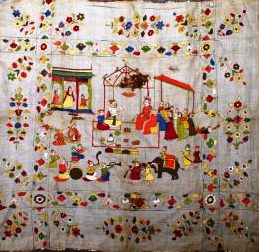
Art history/ Historiography
Kashmiri buta becomes Scottish Paisley: Journey of a motif
Kaur, Jasvinder
Issue 09,Winter 2022
Issue #009, 2022 ISSN: 2581- 9410
On a cold winter wedding in North India one always comes across elegant ladies wearing jamavar or kani shawls with their kundan necklaces and dangling jhumkaas.
The designer of one such wedding proudly tells the mother how he has successfully copied the paisley design and matched the shawl not only on to the bride’s dress but also in small sizes on the bridegroom’s achkan. He proudly tells others that the theme of the wedding is Paisley. There will be Paisley everywhere in décor, clothes and jewe llery. It seems to be an Anglicized theme and topic. Is it really? One wonders as to what exactly is this paisley? Is it a motif or a design? Or is it a Scottish town? Or a design of the old shawls? Or very simply an Indian mango or an ambi, that one sees everywhere from Punjabi juttis to handmade paper, from designer suits to kani shawls and traditional Banarasi or kangivaram Saris. The answer to that is that it has a bit of everything in it’s evolution and history. It is the motif associated with the Kashmiri shawl.
The many names
To a common person a Kashmiri shawl can be anything from an antique long shawl to one with a typical motif – buta, ambi, mango or paisley whatever one may call it. They all mean the same thing. How did a humble ambi then become a paisley?
The name Boteh or buta is of Persian origin and its development has taken many centuries for it to develop into the shape tha...
This is a preview. To access all the essays on the Global InCH Journal a modest subscription cost is being levied to cover costs of hosting, editing, peer reviewing etc. To subscribe, Click Here.



